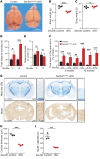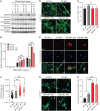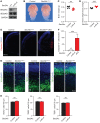The COPII cargo adapter SEC24C is essential for neuronal homeostasis
- PMID: 29939162
- PMCID: PMC6063503
- DOI: 10.1172/JCI98194
The COPII cargo adapter SEC24C is essential for neuronal homeostasis
Abstract
SEC24 family members are components of the coat protein complex II (COPII) machinery that interact directly with cargo or with other adapters to ensure proper sorting of secretory cargo into COPII vesicles. SEC24C is 1 of 4 mammalian SEC24 paralogs (SEC24A-D), which segregate into 2 subfamilies on the basis of sequence homology (SEC24A/SEC24B and SEC24C/SEC24D). Here, we demonstrate that postmitotic neurons, unlike professional secretory cells in other tissues, are exquisitely sensitive to loss of SEC24C. Conditional KO of Sec24c in neural progenitors during embryogenesis caused perinatal mortality and microcephaly, with activation of the unfolded protein response and apoptotic cell death of postmitotic neurons in the murine cerebral cortex. The cell-autonomous function of SEC24C in postmitotic neurons was further highlighted by the loss of cell viability caused by disrupting Sec24c expression in forebrain neurons of mice postnatally and in differentiated neurons derived from human induced pluripotent stem cells. The neuronal cell death associated with Sec24c deficiency was rescued in knockin mice expressing Sec24d in place of Sec24c. These data suggest that SEC24C is a major cargo adapter for COPII-dependent transport in postmitotic neurons in developing and adult brains and that its functions overlap at least partially with those of SEC24D in mammals.
Keywords: Cell stress; Development; Neurodegeneration; Neurodevelopment; Neuroscience.
Conflict of interest statement
Figures








Similar articles
-
Mammalian COPII coat component SEC24C is required for embryonic development in mice.J Biol Chem. 2014 Jul 25;289(30):20858-70. doi: 10.1074/jbc.M114.566687. J Biol Chem. 2014. PMID: 24876386 Free PMC article.
-
Collagen has a unique SEC24 preference for efficient export from the endoplasmic reticulum.Traffic. 2022 Jan;23(1):81-93. doi: 10.1111/tra.12826. Epub 2021 Nov 22. Traffic. 2022. PMID: 34761479 Free PMC article.
-
Murine SEC24D can substitute functionally for SEC24C during embryonic development.Sci Rep. 2021 Oct 26;11(1):21100. doi: 10.1038/s41598-021-00579-x. Sci Rep. 2021. PMID: 34702932 Free PMC article.
-
New insights into the structural mechanisms of the COPII coat.Traffic. 2010 Mar;11(3):303-10. doi: 10.1111/j.1600-0854.2009.01026.x. Epub 2009 Dec 7. Traffic. 2010. PMID: 20070605 Review.
-
COPII coat assembly and selective export from the endoplasmic reticulum.J Biochem. 2004 Dec;136(6):755-60. doi: 10.1093/jb/mvh184. J Biochem. 2004. PMID: 15671485 Review.
Cited by
-
Cargo selection in endoplasmic reticulum-to-Golgi transport and relevant diseases.J Clin Invest. 2023 Jan 3;133(1):e163838. doi: 10.1172/JCI163838. J Clin Invest. 2023. PMID: 36594468 Free PMC article. Review.
-
A COPII subunit acts with an autophagy receptor to target endoplasmic reticulum for degradation.Science. 2019 Jul 5;365(6448):53-60. doi: 10.1126/science.aau9263. Science. 2019. PMID: 31273116 Free PMC article.
-
Consequences of mutations in the genes of the ER export machinery COPII in vertebrates.Cell Stress Chaperones. 2020 Mar;25(2):199-209. doi: 10.1007/s12192-019-01062-3. Epub 2020 Jan 22. Cell Stress Chaperones. 2020. PMID: 31970693 Free PMC article. Review.
-
Dynamic regulation of Sec24C by phosphorylation and O-GlcNAcylation during cell cycle progression.J Biol Chem. 2025 Jul 3;301(8):110456. doi: 10.1016/j.jbc.2025.110456. Online ahead of print. J Biol Chem. 2025. PMID: 40617351 Free PMC article.
-
Evidence for nutrient-dependent regulation of the COPII coat by O-GlcNAcylation.Glycobiology. 2021 Sep 20;31(9):1102-1120. doi: 10.1093/glycob/cwab055. Glycobiology. 2021. PMID: 34142147 Free PMC article.
References
Publication types
MeSH terms
Substances
Grants and funding
LinkOut - more resources
Full Text Sources
Other Literature Sources
Molecular Biology Databases
Research Materials

